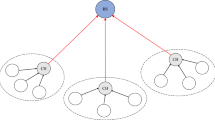Abstract
The MACORA is presented to solve the collision between mobile agent and multicast suppression in channel competitive process. With two-layer graph model, the channel converter problem in the dual-channel wireless sensor networks can be simplified into a routing problem over the two-layered graph, so we can search for routes in the control plane and transport traffic in the data plane synchronously. Then, the control plane and the data plane are integrated into a two-layered network, and searching for route for each traffic in the two-layer networks synchronously. The MACORA can make full use of the idle resource in different layers, this strategy deals with the collision between mobile agent and multicast suppression in channel competitive process well, so the blocking probability of networks and the error rate of packet transmission can be cut down. Simulation results show that the MACORA performs better in improving success rate of packet transmission.
Similar content being viewed by others
References
Gallais A., Carle J., Stojmenovic I. (2008) Localized sensor area coverage with low communication overhead. IEEE Transactions On Mobile Computing 7(5): 661–672
Anastasi G., Conti M., Passarella A. et al (2009) Energy conservation in wireless sensor networks: A survey. Ad Hoc Networks 7(3): 537–568
Chang Y.C., Sheu J.-P. (2009) An energy conservation MAC protocol in wireless sensor networks. Wireless Personal Communications 48(2): 261–276
Kim S. (2012) Adaptive online sensor clustering and routing algorithms for QoS provisioning and energy efficiency. Wireless Personal Communications 63(4): 965–975
Vizireanu, D. N., & Halunga S. V. (2012, April) Simple, fast and accurate eight points amplitude estimation method of sinusoidal signals for DSP based instrumentation. Journal of Instrumentation, 7(JINST 7), 1–10.
Vizireanu D. N (2012) A fast, simple and accurate time-varying frequency estimation method for single phase electric power systems. Measurement 45(6): 1331–1333
Cano J.-C., Manzoni P., Kim D. (2007) A low-complexity routing algorithm with power control for self-organizing short-range wireless networks. Wireless Personal Communications 41(3): 407–425
Cormio C., Chowdhury K. R. (2009) A survey on MAC protocol for cognitive radio networks. Ad Hoc Networks 7(7): 1315–1329
Li L., Jiang W. (2009) A receiver-based cross-layer forwarding protocol for mobile sensor networks. Journal of Computer Research and Development 46(1): 120–128
Awwad S. A. B., Ng C. K., Noordin N.K., Rasid M. F. A. (2011) Cluster based routing protocol for mobile nodes in wireless sensor network. Wireless Personal Communications 61(2): 251–281
Fok C. L., Roman G. C., Chenyang L. U. (2009) Agilla: A mobile agent middleware for self-adaptive wireless sensor networks. ACM Transactions on Autonomous and Adaptive Systems 4(3): 4–29
Li Z., Shi H. (2008) A data aggregation algorithm based on grid and mobile agent in WSN. Chinese Journal of sensor and actuators 21(7): 624–628
Chen M., Taekyoung K., Yong Y. et al (2006) Mobile agent based wireless sensor networks. Journal of Computers 1(1): 14–21
Zheng W., Liu S., Kou X. (2010) Dynamic mobile agent routing algorithm in sensors network. Control and Decision 25(7): 1035–1039
Li Z., Shi H. (2009) A data-aggregation algorithm based on minimum Steiner tree in wireless sensor network. Journal of Northwestern Poly technical University 27(4): 558–564
Zheng W., Liu S., Kou X. (2010) A route restoration algorithm for sensor network via ant colony optimization. Journal of XI’AN Jiao Tong University 25(7): 1035–1039
Bohacek S. (2008) Performance improvements provided by route discovery in multi-hop wireless networks. IEEE Transactions on Mobile Computing 7(3): 372–384
Ferng H.-W., Tendean R., Kurniawan A. (2012) Energy-efficient routing protocol for wireless sensor networks with static clustering and dynamic structure. Wireless Personal Communications 65(2): 347–367
Shee S.-H., Chang T.-C., Wang K. et al (2011) Efficient color-theory-based dynamic localization for mobile wireless sensor networks. Wireless Personal Communications 59(2): 375–396
Vizireanu D. N., Halunga S. V. (2011) Single sine wave parameters estimation method based on four equally spaced samples. International Journal of Electronics 98(7): 941–948
Vizireanu D. N., Halunga S. V. (2012) Analytical formula for three points sinusoidal signals amplitude estimation errors. International Journal of Electronics 99(1): 149–151
Barnhart, D. J., Vladimirova, T., & Sweeting, M. N. (2007). System-on-a-chip design of self-powered wireless sensor nodes for hostile environments. In Aerospace conference 2007 IEEE, Montana, USA, 2007.
Marco D., Thomas S. (2006) Ant colony optimization. Copyright by the MIT press, Italy
Alkaraki J. N., Kamal A. E. (2004) Routing techniques in wireless sensor networks: A survey. Wireless Communications 11(6): 6–28
Brenna S. M., Mielke A. M., Torney D. C. (2004) Radiation with distributed sensor networks. Computer 37(8): 57–59
Fei H., Meng J., Celentano L. et al (2008) Robust medical ad hoc sensor networks(MASN) with wavelet-based ECG data mining. Ad Hoc Networks 6(7): 986–1012
Talukder, A., Panangadan, A., & Herrington, T. (2008). Autonomous adaptive resource management in sensor networks system for environmental monitoring. In Aerospace Conference 2008 IEEE, Montana, USA, 2008.
Kim, S., Pakzad, S. Culler, D., et al. (2006) Wireless sensor networks for structural health monitoring. In Proceedings of the 4th international conference on embedded networked sensor systems, Boulder, Colorado, USA, 2006, pp. 427–428.
Boyd, S., Ghosh, A., Prabbakar, B., et al. (2005). Gossip algorithms: Design, analysis and applications. In Proceedings of IEEE INFOCOM’05, pp. 1653–1664
Younis M., Youssef M., Arisha K. (2002) Energy-aware management in cluster-based sensor networks. Sensor Magazine 19(2): 258–269
Author information
Authors and Affiliations
Corresponding author
Rights and permissions
About this article
Cite this article
Jin, R., Kou, C., Liu, R. et al. A Co-optimization Routing Algorithm in Wireless Sensor Network. Wireless Pers Commun 70, 1977–1991 (2013). https://doi.org/10.1007/s11277-012-0791-3
Published:
Issue Date:
DOI: https://doi.org/10.1007/s11277-012-0791-3




